The Intel Broadwell Xeon E3 v4 Review: 95W, 65W and 35W with eDRAM
by Ian Cutress on August 26, 2015 9:00 AM ESTIntel Broadwell Xeon E3 v4 Conclusions
If you skipped to the end without looking at the benchmark data, we’re going to throw a few graphs in here for good measure.
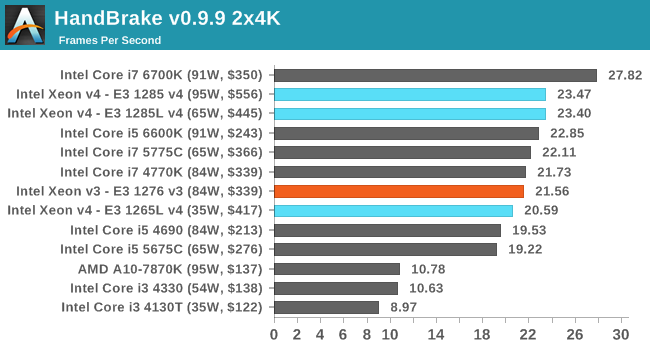
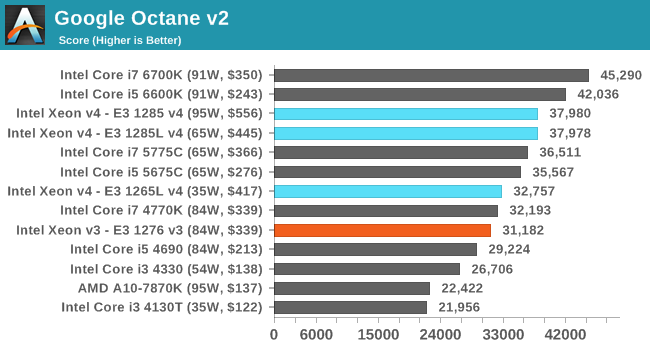
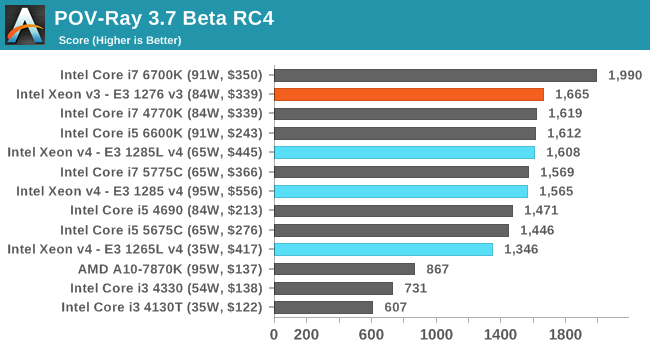
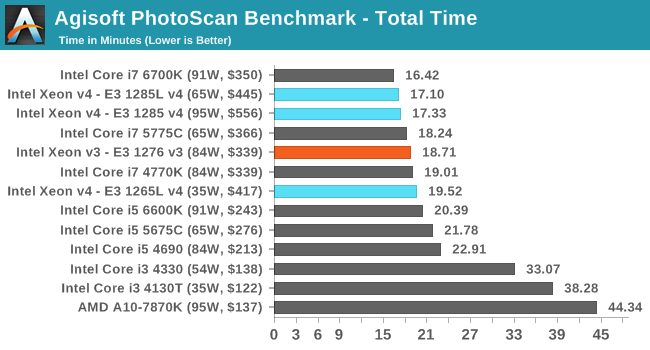
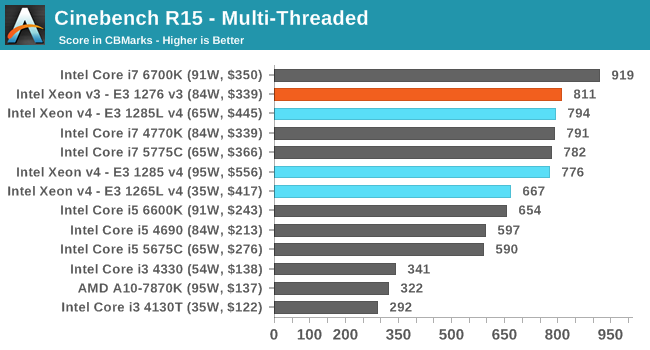
We said at the start of this review that one of the key parts to examine was the main parallel to the 95W of the E3-1285 v4 and the E3-1276 v3 at 84W due to their near similar (but not ideal) thermal design power metrics. The differentiator here is that the E3 v3 has some extra frequency, but the E3 v4 range has eDRAM.
At least, we thought this should be the battle to be had, but it is clear from the results that something else is more interesting. Comparing the E3-1285 v4 at 95W to its lower power variant, the E3-1285L v4 at 65W, we see that the low power variant scores better on almost all benchmarks.
The only difference between these two processors aside from the 30W of TDP should be the 100 MHz gap in favor of the 95W part. We said at the beginning that this 100 MHz does not adequately explain 30W in the grand scheme of things, so the lower powered model must also have a substantially better voltage/frequency profile. This, as it happens, has some knock on side effects.
In a couple of CPU tests, the extra frequency wins. This boils down to only 3DPM and Sunspider, both tests that arguably are neither extensively pressing the processor nor exhaustive in their capabilities. But the lower power model, by virtue of the better binning, is able to keep its higher frequency turbo mode available for 100% of the time in our testing, ultimately giving a higher frequency and completing work quicker. This is despite the base frequency of the E3-1285 v4 being higher, and alluding to a variable turbo frequency profile based on power draw. To cap it off, the E3-1285L v4 is also $111 cheaper. So when the two processors are put side-by-side, the decision is obvious. We would choose the E3-1285L v4 every time.
This means the title fight should be between the 65W E3-1285L v4 and the E3-1276 v3 at 84W. Here it gets a little more edgy – the v4 here is technically 100 MHz above the i7-5775C which we looked at in our last Broadwell review, and we get more into a performance/power based efficiency discussion based on the TDP difference than the 95W vs 84W discussion.
In DRAM heavy scenarios such as WinRAR, which requires a large amount of cache to retain dictionary compression tables, the benefits of the eDRAM are easy to see. Benchmarks on the integrated graphics also win out due to the Iris Pro P6300. For discrete graphics, the Broadwell parts certain win over the v3 for efficiency at this point, with results between the two being almost identical. But the big one to note here is Photoscan in pure CPU mode, where Broadwell takes a minor lead – Photoscan uses a set of fifty two-dimensional photos with no depth information to create a three-dimensional imagine over several stages, so managing that data around the memory subsystem becomes a handful when there are 40,000 data points per picture in flight. This benchmark was suggested to us by an archivist at a national library who uses it to recreate models of the artifacts in their storage for external examination.
For all the other CPU tests, a dichotomy appears. The higher frequency v3 wins for compute driven performance, but data driven metrics (and efficiency) are the realm of Broadwell, Xeon or otherwise, as long as there is frequency to match.
As mentioned on the first page of the review, on the suggestion of a number of our readers and based on these interesting, we are looking into other avenues which are also data driven. Previously our Chrome compilation benchmark was a featured set piece in our testing, but has fallen away and a similar equivalent needs to be reintroduced. As a result, we are speaking to some users and looking into a series of tests of this nature that afford a repeatable and consistent point of analysis – ideally in an automated context if possible and encompassing a variety of projects and languages. At current there is no time framework for introduction, but September affords some time to focus on the project and then test a number of processors on it. Thoughts and suggestions should be forwarded to ian@anandtech.com.


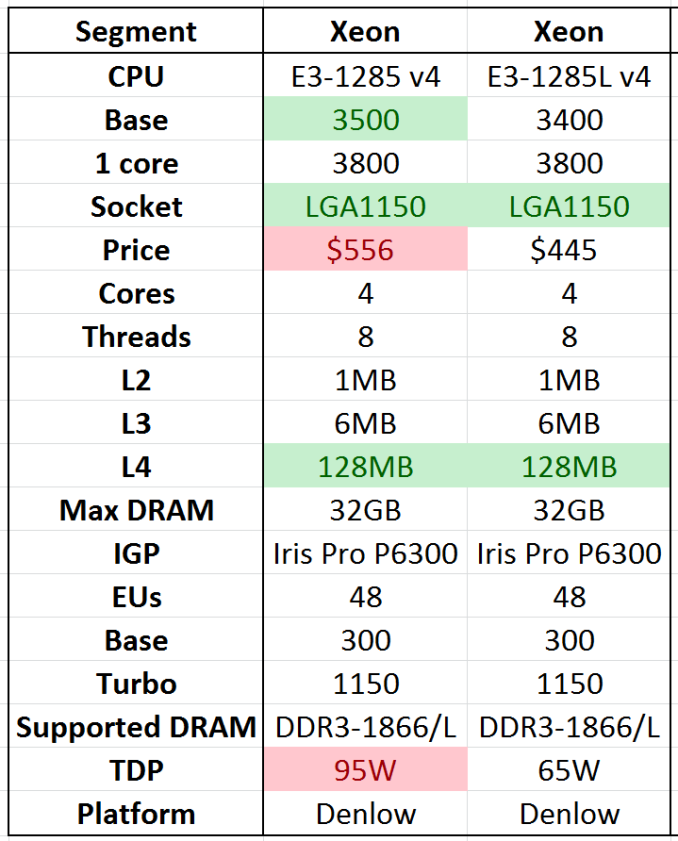
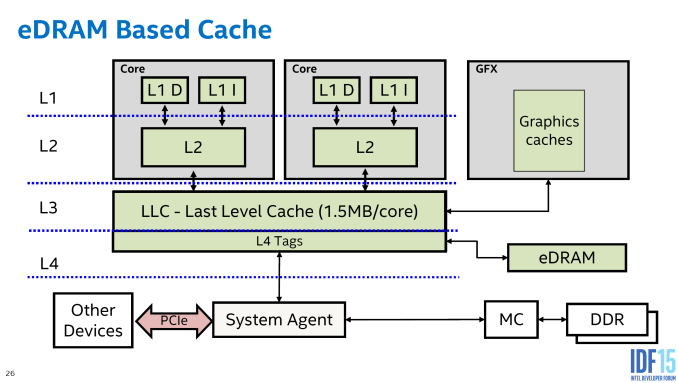








72 Comments
View All Comments
ruthan - Thursday, August 27, 2015 - link
So pleas add some virtualization into benchmarking set.Ian Cutress - Thursday, August 27, 2015 - link
It's on the cards.Mastadon - Thursday, August 27, 2015 - link
No support for DDR4 RAM? C'mon, it's 2015.SuperVeloce - Thursday, August 27, 2015 - link
This is Broadwell, not Skylake... It's meant to introduce new litography process and updated platform, not new arhitectures and memory controllers...Oxford Guy - Thursday, August 27, 2015 - link
DDR4 isn't of much benefit, except for servers (power consumption)AnnonymousCoward - Thursday, August 27, 2015 - link
Skylake FTW. Why pay more for the slower Xeon?Oxford Guy - Thursday, August 27, 2015 - link
If you read the Skylake review here you'll find that it's not really better than Broadwell, just different.AnnonymousCoward - Thursday, August 27, 2015 - link
Dude, look at the graphs on the conclusion page of this review. Skylake beats the closest Xeon by 19% in most of them.Oxford Guy - Sunday, August 30, 2015 - link
I wasn't talking about Xeon. Look at the previous desktop review. I read your post too quickly and missed that you were talking about Xeon.joex4444 - Thursday, August 27, 2015 - link
Is it even clear that the 1285 and 1285L performed differently to a statistically significant degree? I mean if one has a benchmark performed three times and scores of, say, {1176, 1188, 1182} are obtained for the 1285 but the 1285L gets {1190, 1175, 1184} then the 1285L seems to have an average of 1183 while the 1285 has an average of 1182. But when we look at those distributions, they completely agree and show no performance difference, which given one has an extra 100MHz on it we'd expect a 1 part in 34 advantage, ie, a 2.9% performance gap with the 95W 1285 outperforming the 65W 1285L.Further, it's important to recall the first chart showing that the 95W 1285 actually used less power in the idle -> OCCT test. The TDP is not a measure of how much power the CPU uses, plain and simple. It's a specification stating the maximum amount of power that can be dissipated in the form of heat. Therefore when the author states "100MHz does not adequately explain 30W in the grand scheme of things" they're exactly correct about the TDP, but it comes off suggesting one actually *uses* 30W more than the other which is simply not true. It does sound pretty clear that either (a) Intel bins their TDPs and the 3.5GHz one bumped up past the 65W bin or (b) Intel uses better parts for the 1285L, but this does not explain why it would cost $100-ish (~18%) less as we would expect better parts to be scarcer not more abundant.
As far as binned TDPs go, we know they do this. Look at the 84W parts. They don't all use 84W, they're just all rated as capable of dissipating up to 84W. Further we don't see arbitrary TDPs, we see a few, eg, 35W, 65W, 84W, 95W, 125W, and if you're AMD, 220W.